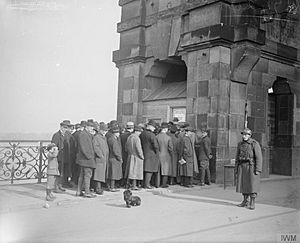Occupation of the Rhineland facts for kids
Quick facts for kids 
French soldiers at Ehrenbreitstein Fortress watching over the Deutsches Eck, 1929
|
|
| Date | 1 December 1918 – 30 June 1930 |
|---|---|
| Duration | 11 years, 6 months, 4 weeks and 1 day |
| Location | Left Bank of the Rhine, Germany |
The Occupation of the Rhineland was a time when parts of Germany were controlled by other countries. This happened after World War I ended in 1918. Germany's army had collapsed, and the country had to agree to the terms of an armistice.
This agreement meant that soldiers from the winning countries would occupy the land west of the Rhine River. They also occupied four "bridgeheads" on the east side of the Rhine. These were areas around the cities of Cologne, Koblenz, Mainz, and Kehl.
The main reasons for this occupation were to keep France safe from another German attack. It also made sure Germany paid for the damages caused by the war, known as reparations. The occupation lasted from December 1, 1918, until June 30, 1930.
Contents
Why the Rhineland Was Occupied
After World War I, the winning countries wanted to make sure Germany could not start another war. They also wanted Germany to pay for the damage caused by the war. The Rhineland region was important because it bordered France and was a key industrial area.
The Treaty of Versailles, signed in 1919, confirmed these plans. It said that foreign troops could stay in the Rhineland for up to fifteen years. The left bank of the Rhine and a strip of land 50 kilometers (about 31 miles) wide on the east side were declared a demilitarized zone. This meant Germany was not allowed to have soldiers or military bases there.
The region was managed by a group called the Inter-Allied Rhineland High Commission. This commission was based in Koblenz. The occupation ended early in 1930, after Germany agreed to a new plan for paying reparations.
Timeline of the Occupation
The occupation of the Rhineland had several important dates and events:
- November 11, 1918: The armistice was signed, ending World War I.
- December 1, 1918: The occupation of the Rhineland officially began.
- June 28, 1919: The Treaty of Versailles was signed. This treaty set the rules for the occupation.
- January 10, 1920: The Treaty of Versailles became official. The Inter-Allied Rhineland High Commission was formed to govern the occupied areas.
- January 11, 1923: French and Belgian troops occupied the Ruhr area. This happened because Germany was not paying its war reparations.
- 1926: Troops left the northern zone around Cologne.
- 1929: Troops left the central zone around Koblenz.
- 1930: Troops left the southern zone around Mainz, ending the occupation.
- March 7, 1936: German troops under Adolf Hitler re-entered the Rhineland. This went against the Treaty of Versailles.
Countries That Occupied the Rhineland
Several Allied countries sent their armies to occupy different parts of the Rhineland. These included the United States, Belgium, Britain, and France.
American Forces (1918–1923)
The United States occupied the central part of the Rhineland, near the Mosel River and the city of Koblenz. The American forces were first called the Third Army. Later, they became the American Forces in Germany (AFG).
At its largest, the American force had about 250,000 soldiers. Their headquarters were in Koblenz, and the US flag flew over Ehrenbreitstein Fortress. The Americans generally had a better relationship with the German people than the French forces did.
In January 1923, the U.S. decided to withdraw its troops from Germany. The last American soldiers left Koblenz by February 1923. Their zone was then taken over by the French army.
Belgian Army of Occupation
Belgium also had an army in the Rhineland from 1918 to 1929. This army had about 20,000 soldiers. Their main base was in Aachen, and troops were also stationed in Krefeld.
Belgian soldiers also took part in the Occupation of the Ruhr in 1923. During this time, some Belgian soldiers were killed in an attack near Hochfeld.
British Army of the Rhine
The British Army entered Germany in December 1918. The British Army of the Rhine was officially formed in March 1919. Their main base was in Cologne. They even published a newspaper called The Cologne Post.
French Army of the Rhine
The French army had the largest presence in the Rhineland. They initially used their Eighth and Tenth Armies for the occupation. The Eighth Army was in charge of the Palatinate region. The Tenth Army was responsible for the rest of the French zone, with its headquarters in Mainz.
In 1919, these two armies were combined to form the French Army of the Rhine. France also used many colonial soldiers from its overseas territories in the Rhineland.
Occupation of Frankfurt
French troops occupied Frankfurt from April to May 1920. During this time, some civilians were shot by Moroccan troops. This event led to strong protests and anger in Germany.
Occupation of the Ruhr
In 1923, France and Belgium occupied the Ruhr area of Germany. This was a very important industrial region. They did this because Germany was not paying its war reparations as agreed in the Treaty of Versailles. This occupation lasted until 1925. There were protests and some violence during this period.
Siamese Expeditionary Forces
Soldiers from Thailand (then called Siam) also helped with the occupation until 1919. Their troops were stationed in Neustadt an der Weinstraße, which was in the French zone.
See also
- Free State Bottleneck
- Rhenish Republic
- Rhineland




